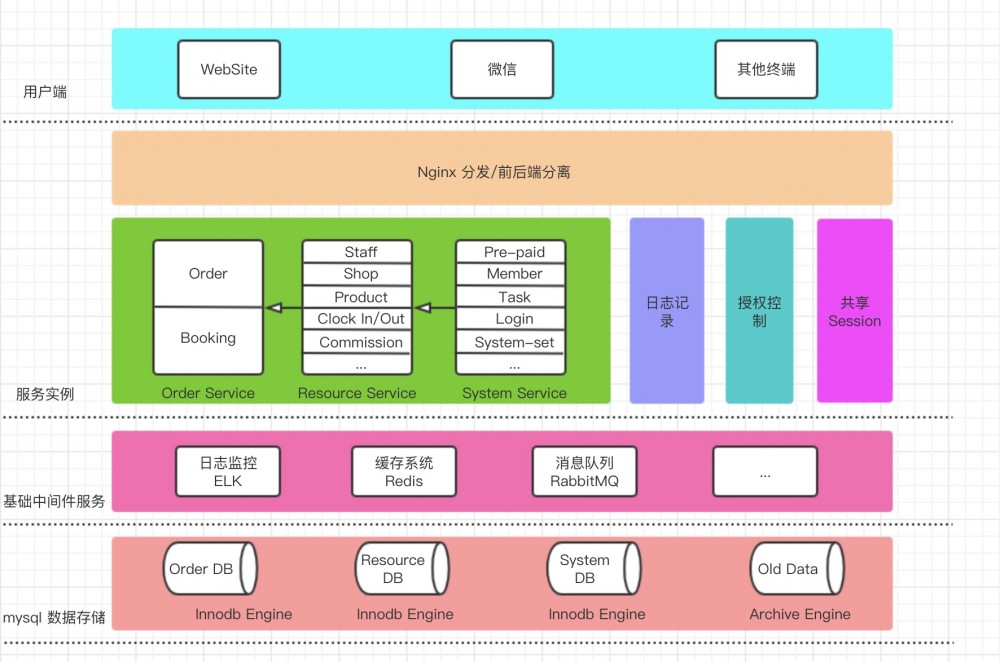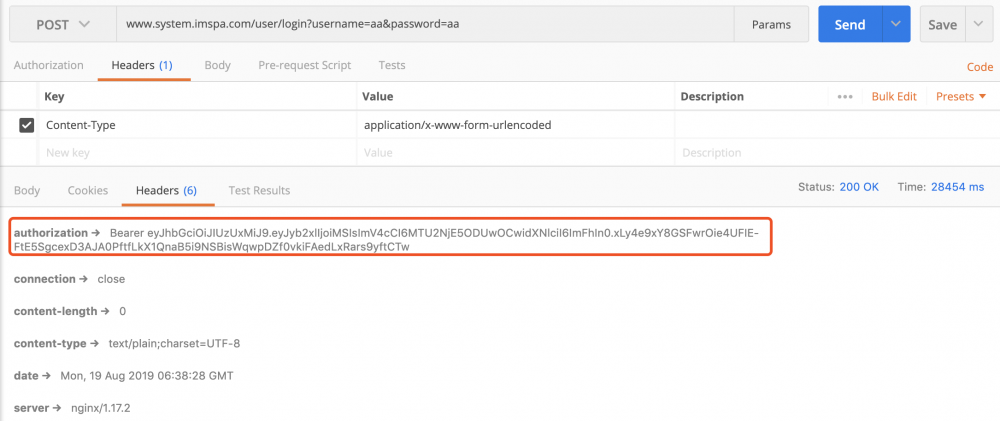基于Spring Boot自建分布式基础应用
目前刚入职了一家公司,要求替换当前系统(单体应用)以满足每日十万单量和一定系统用户负载以及保证开发质量和效率。由我来设计一套基础架构和建设基础开发测试运维环境, github地址 。
出于本公司开发现状及成本考虑,我摒弃了市面上流行的Spring Cloud以及Dubbo分布式基础架构,舍弃了集群的设计,以Spring Boot和Netty为基础自建了一套RPC分布式应用架构。可能这里各位会有疑问,为什么要舍弃应用的高可用呢?其实这也是跟公司的产品发展有关的,避免过度设计是非常有必要的。下面是整个系统的架构设计图。 
这里简单介绍一下,这里ELK或许并非最好的选择,可以另外采用zabbix或者prometheus,我只是考虑了后续可能的扩展。数据库采用了两种存储引擎,便是为了因对上面所说的每天十万单的大数据量,可以采用定时脚本的形式完成数据的转移。
权限的设计主要是基于JWT+Filter+Redis来做的。Common工程中的com.imspa.web.auth.Permissions定义了所有需要的permissions:
1 package com.imspa.web.auth;
2
3 /**
4 * @author Pann
5 * @description TODO
6 * @date 2019-08-12 15:09
7 */
8 public enum Permissions {
9 ALL("/all", "所有权限"),
10 ROLE_GET("/role/get/**", "权限获取"),
11 USER("/user", "用户列表"),
12 USER_GET("/user/get", "用户查询"),
13 RESOURCE("/resource", "资源获取"),
14 ORDER_GET("/order/get/**","订单查询");
15
16 private String url;
17 private String desc;
18
19 Permissions(String url, String desc) {
20 this.url = url;
21 this.desc = desc;
22 }
23
24 public String getUrl() {
25 return this.url;
26 }
27
28 public String getDesc() {
29 return this.desc;
30 }
31 }
如果你的没有为你的接口在这里定义权限,那么系统是不会对该接口进行权限的校验的。在数据库中User与Role的设计如下:
1 CREATE TABLE IF NOT EXISTS `t_user` ( 2 `id` VARCHAR(36) NOT NULL, 3 `name` VARCHAR(20) NOT NULL UNIQUE, 4 `password_hash` VARCHAR(255) NOT NULL, 5 `role_id` VARCHAR(36) NOT NULL, 6 `role_name` VARCHAR(20) NOT NULL, 7 `last_login_time` TIMESTAMP(6) NULL, 8 `last_login_client_ip` VARCHAR(15) NULL, 9 `created_time` TIMESTAMP(6) NOT NULL DEFAULT CURRENT_TIMESTAMP(6), 10 `created_by` VARCHAR(36) NOT NULL, 11 `updated_time` TIMESTAMP(6) NULL, 12 `updated_by` VARCHAR(36) NULL, 13 PRIMARY KEY (`id`) 14 ); 15 16 CREATE TABLE IF NOT EXISTS `t_role` ( 17 `id` VARCHAR(36) NOT NULL, 18 `role_name` VARCHAR(20) NOT NULL UNIQUE, 19 `description` VARCHAR(90) NULL, 20 `permissions` TEXT NOT NULL, #其数据格式类似于"/role/get,/user"或者"/all" 21 `created_time` TIMESTAMP(6) NOT NULL DEFAULT CURRENT_TIMESTAMP(6), 22 `created_by` VARCHAR(36) NOT NULL, 23 `updated_time` TIMESTAMP(6) NULL, 24 `updated_by` VARCHAR(36) NULL, 25 PRIMARY KEY (`id`) 26 );
需要注意的是"/all"代表了所有权限,表示root权限。我们通过postman调用登陆接口可以获取相应的token:

这个token是半个小时失效的,如果你需要更长一些的话,可以通过com.imspa.web.auth.TokenAuthenticationService进行修改:
1 package com.imspa.web.auth;
2
3 import com.imspa.web.util.WebConstant;
4 import io.jsonwebtoken.Jwts;
5 import io.jsonwebtoken.SignatureAlgorithm;
6
7 import java.util.Date;
8 import java.util.Map;
9
10 /**
11 * @author Pann
12 * @description TODO
13 * @date 2019-08-14 23:24
14 */
15 public class TokenAuthenticationService {
16 static final long EXPIRATIONTIME = 30 * 60 * 1000; //TODO
17
18 public static String getAuthenticationToken(Map<String, Object> claims) {
19 return "Bearer " + Jwts.builder()
20 .setClaims(claims)
21 .setExpiration(new Date(System.currentTimeMillis() + EXPIRATIONTIME))
22 .signWith(SignatureAlgorithm.HS512, WebConstant.WEB_SECRET)
23 .compact();
24 }
25 }
Refresh Token目前还没有实现,后续我会更新,请关注我的 github 。如果你跟踪登陆逻辑代码,你可以看到我把role和user都缓存到了Redis:
1 public User login(String userName, String password) {
2 UserExample example = new UserExample();
3 example.createCriteria().andNameEqualTo(userName);
4
5 User user = userMapper.selectByExample(example).get(0);
6 if (null == user)
7 throw new UnauthorizedException("user name not exist");
8
9 if (!StringUtils.equals(password, user.getPasswordHash()))
10 throw new UnauthorizedException("user name or password wrong");
11
12 roleService.get(user.getRoleId()); //for role cache
13
14 hashOperations.putAll(RedisConstant.USER_SESSION_INFO_ + user.getName(), hashMapper.toHash(user));
15 hashOperations.getOperations().expire(RedisConstant.USER_SESSION_INFO_ + user.getName(), 30, TimeUnit.MINUTES);
16
17 return user;
18 }
在Filter中,你可以看到过滤器的一系列逻辑,注意返回http状态码401,403和404的区别:
1 package com.imspa.web.auth;
2
3 import com.imspa.web.Exception.ForbiddenException;
4 import com.imspa.web.Exception.UnauthorizedException;
5 import com.imspa.web.pojo.Role;
6 import com.imspa.web.pojo.User;
7 import com.imspa.web.util.RedisConstant;
8 import com.imspa.web.util.WebConstant;
9 import io.jsonwebtoken.Claims;
10 import io.jsonwebtoken.Jwts;
11 import org.apache.commons.lang3.StringUtils;
12 import org.apache.logging.log4j.LogManager;
13 import org.apache.logging.log4j.Logger;
14 import org.springframework.data.redis.core.HashOperations;
15 import org.springframework.data.redis.hash.HashMapper;
16 import org.springframework.util.AntPathMatcher;
17
18 import javax.servlet.Filter;
19 import javax.servlet.FilterChain;
20 import javax.servlet.FilterConfig;
21 import javax.servlet.ServletException;
22 import javax.servlet.ServletOutputStream;
23 import javax.servlet.ServletRequest;
24 import javax.servlet.ServletResponse;
25 import javax.servlet.http.HttpServletRequest;
26 import javax.servlet.http.HttpServletResponse;
27 import java.io.IOException;
28 import java.util.Date;
29 import java.util.HashMap;
30 import java.util.Map;
31 import java.util.Optional;
32 import java.util.concurrent.TimeUnit;
33
34 /**
35 * @author Pann
36 * @description TODO
37 * @date 2019-08-16 14:39
38 */
39 public class SecurityFilter implements Filter {
40 private static final Logger logger = LogManager.getLogger(SecurityFilter.class);
41 private AntPathMatcher matcher = new AntPathMatcher();
42 private HashOperations<String, byte[], byte[]> hashOperations;
43 private HashMapper<Object, byte[], byte[]> hashMapper;
44
45 public SecurityFilter(HashOperations<String, byte[], byte[]> hashOperations, HashMapper<Object, byte[], byte[]> hashMapper) {
46 this.hashOperations = hashOperations;
47 this.hashMapper = hashMapper;
48 }
49
50 @Override
51 public void init(FilterConfig filterConfig) throws ServletException {
52
53 }
54
55 @Override
56 public void doFilter(ServletRequest servletRequest, ServletResponse servletResponse, FilterChain chain) throws IOException, ServletException {
57 HttpServletRequest request = (HttpServletRequest) servletRequest;
58 HttpServletResponse response = (HttpServletResponse) servletResponse;
59
60 Optional<String> optional = PermissionUtil.getAllPermissionUrlItem().stream()
61 .filter(permissionItem -> matcher.match(permissionItem, request.getRequestURI())).findFirst();
62 if (!optional.isPresent()) { //TODO some api not config permission will direct do
63 chain.doFilter(servletRequest, servletResponse);
64 return;
65 }
66
67 try {
68 validateAuthentication(request, optional.get());
69 flushSessionAndToken(((User) request.getAttribute("userInfo")), response);
70 chain.doFilter(servletRequest, servletResponse);
71 } catch (ForbiddenException e) {
72 logger.debug("occur forbidden exception:{}", e.getMessage());
73 response.setStatus(403);
74 ServletOutputStream output = response.getOutputStream();
75 output.print(e.getMessage());
76 output.flush();
77 } catch (UnauthorizedException e) {
78 logger.debug("occur unauthorized exception:{}", e.getMessage());
79 response.setStatus(401);
80 ServletOutputStream output = response.getOutputStream();
81 output.print(e.getMessage());
82 output.flush();
83 }
84 }
85
86 @Override
87 public void destroy() {
88
89 }
90
91 private void validateAuthentication(HttpServletRequest request, String permission) {
92 String authHeader = request.getHeader("Authorization");
93 if (StringUtils.isEmpty(authHeader))
94 throw new UnauthorizedException("no auth header");
95
96 Claims claims;
97 try {
98 claims = Jwts.parser().setSigningKey(WebConstant.WEB_SECRET)
99 .parseClaimsJws(authHeader.replace("Bearer ", ""))
100 .getBody();
101 } catch (Exception e) {
102 throw new UnauthorizedException(e.getMessage());
103 }
104
105 String userName = (String) claims.get("user");
106 String roleId = (String) claims.get("role");
107
108 if (StringUtils.isEmpty(userName) || StringUtils.isEmpty(roleId))
109 throw new UnauthorizedException("token error,user:" + userName);
110
111 if (new Date().getTime() > claims.getExpiration().getTime())
112 throw new UnauthorizedException("token expired,user:" + userName);
113
114
115 User user = (User) hashMapper.fromHash(hashOperations.entries(RedisConstant.USER_SESSION_INFO_ + userName));
116 if (user == null)
117 throw new UnauthorizedException("session expired,user:" + userName);
118
119
120 if (validateRolePermission(permission, user))
121 request.setAttribute("userInfo", user);
122 }
123
124 private Boolean validateRolePermission(String permission, User user) {
125 Role role = (Role) hashMapper.fromHash(hashOperations.entries(RedisConstant.ROLE_PERMISSION_MAPPING_ + user.getRoleId()));
126 if (role.getPermissions().contains(Permissions.ALL.getUrl()))
127 return Boolean.TRUE;
128
129 if (role.getPermissions().contains(permission))
130 return Boolean.TRUE;
131
132 throw new ForbiddenException("do not have permission for this request");
133 }
134
135 private void flushSessionAndToken(User user, HttpServletResponse response) {
136 hashOperations.getOperations().expire(RedisConstant.USER_SESSION_INFO_ + user.getName(), 30, TimeUnit.MINUTES);
137
138 Map<String, Object> claimsMap = new HashMap<>();
139 claimsMap.put("user", user.getName());
140 claimsMap.put("role", user.getRoleId());
141 response.setHeader("Authorization",TokenAuthenticationService.getAuthenticationToken(claimsMap));
142 }
143
144 }
下面是RPC的内容,我是用Netty来实现整个RPC的调用的,其中包含了心跳检测,自动重连的过程,基于Spring Boot的实现,配置和使用都还是很方便的。
我们先看一下service端的写法,我们需要先定义好对外服务的接口,这里我们在application.yml中定义:
1 service: 2 addr: localhost:8091 3 interfaces: 4 - 'com.imspa.api.OrderRemoteService'
其中service.addr是对外发布的地址,service.interfaces是对外发布的接口的定义。然后便不需要你再定义其他内容了,是不是很方便?其实现你可以根据它的配置类com.imspa.config.RPCServiceConfig来看:
1 package com.imspa.config;
2
3 import com.imspa.rpc.core.RPCRecvExecutor;
4 import com.imspa.rpc.model.RPCInterfacesWrapper;
5 import org.springframework.beans.factory.annotation.Value;
6 import org.springframework.boot.context.properties.ConfigurationProperties;
7 import org.springframework.boot.context.properties.EnableConfigurationProperties;
8 import org.springframework.context.annotation.Bean;
9 import org.springframework.context.annotation.Configuration;
10
11 /**
12 * @author Pann
13 * @description config order server's RPC service method
14 * @date 2019-08-08 14:51
15 */
16 @Configuration
17 @EnableConfigurationProperties
18 public class RPCServiceConfig {
19 @Value("${service.addr}")
20 private String addr;
21
22 @Bean
23 @ConfigurationProperties(prefix = "service")
24 public RPCInterfacesWrapper serviceContainer() {
25 return new RPCInterfacesWrapper();
26 }
27
28 @Bean
29 public RPCRecvExecutor recvExecutor() {
30 return new RPCRecvExecutor(addr);
31 }
32
33 }
在client端,我们也仅仅只需要在com.imspa.config.RPCReferenceConfig中配置一下我们这个工程所需要调用的service 接口(注意所需要配置的内容哦):
1 package com.imspa.config;
2
3 import com.imspa.api.OrderRemoteService;
4 import com.imspa.rpc.core.RPCSendExecutor;
5 import org.springframework.context.annotation.Bean;
6 import org.springframework.context.annotation.Configuration;
7
8 /**
9 * @author Pann
10 * @Description config this server need's reference bean
11 * @Date 2019-08-08 16:55
12 */
13 @Configuration
14 public class RPCReferenceConfig {
15 @Bean
16 public RPCSendExecutor orderService() {
17 return new RPCSendExecutor<OrderRemoteService>(OrderRemoteService.class,"localhost:8091");
18 }
19
20 }
然后你就可以在代码里面正常的使用了
1 package com.imspa.resource.web;
2
3 import com.imspa.api.OrderRemoteService;
4 import com.imspa.api.order.OrderDTO;
5 import com.imspa.api.order.OrderVO;
6 import org.springframework.beans.factory.annotation.Autowired;
7 import org.springframework.web.bind.annotation.GetMapping;
8 import org.springframework.web.bind.annotation.PathVariable;
9 import org.springframework.web.bind.annotation.RequestMapping;
10 import org.springframework.web.bind.annotation.RestController;
11
12 import java.math.BigDecimal;
13 import java.util.Arrays;
14 import java.util.List;
15
16 /**
17 * @author Pann
18 * @Description TODO
19 * @Date 2019-08-08 16:51
20 */
21 @RestController
22 @RequestMapping("/resource")
23 public class ResourceController {
24 @Autowired
25 private OrderRemoteService orderRemoteService;
26
27 @GetMapping("/get/{id}")
28 public OrderVO get(@PathVariable("id")String id) {
29 OrderDTO orderDTO = orderRemoteService.get(id);
30 return new OrderVO().setOrderId(orderDTO.getOrderId()).setOrderPrice(orderDTO.getOrderPrice())
31 .setProductId(orderDTO.getProductId()).setProductName(orderDTO.getProductName())
32 .setStatus(orderDTO.getStatus()).setUserId(orderDTO.getUserId());
33 }
34
35 @GetMapping()
36 public List<OrderVO> list() {
37 return Arrays.asList(new OrderVO().setOrderId("1").setOrderPrice(new BigDecimal(2.3)).setProductName("西瓜"));
38 }
39 }
以上是本基础架构的大概内容,还有很多其他的内容和后续更新请关注我的 github ,笔芯。
- 本文标签: Select 高可用 root example 存储引擎 https message 配置 IO spring 代码 list 架构设计 质量 core 2019 数据库 constant IDE parse 分布式 web dubbo equals git Logging map executor rmi GitHub value token remote src stream description Service redis HTML Spring Boot apache final session ip ACE 集群 cache Netty key bug tab client zab find Security 数据 App id update 开发 HashMap servlet Word cat mapper API json ELK 测试 build 缓存 js Authorization UI CTO 应用架构 java REST Spring cloud http 产品 bean 大数据
- 版权声明: 本文为互联网转载文章,出处已在文章中说明(部分除外)。如果侵权,请联系本站长删除,谢谢。
- 本文海报: 生成海报一 生成海报二











![[HBLOG]公众号](https://www.liuhaihua.cn/img/qrcode_gzh.jpg)

